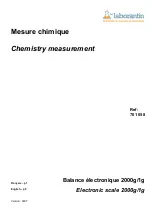
SmartScale 600
User Manual
Page 33
Weight gain screen
The Weight gain screen shows weight gain data for the animal being
weighed and weight gain statistics for all animals in the session.
The weight gain graph on the left side of the screen shows the change
in an animal's weight gain from one session to the next. The vertical
axis represents weight gain, the horizontal axis represents time. Each
point on the graph represents the weight gain (in kg/day) that occurred
between two weighing sessions.
For example, if the graph slopes upward, the rate of weight gain has
increased. If the graph slopes downward the rate of weight gain has
decreased.
Note
: Provided the weight gain figure is positive the animal has gained
weight. The graph plots changes in weight gain not changes in
weight. A downward slope in the line on the graph indicates a
decrease in the rate of weight gain, not a decrease in actual weight.
The weight gain (in kg/day) for the animal currently being weighed is
displayed in the top left corner of the screen. This is also the last point
on the graph. For example, in the screen shown above, the weight gain
for the current animal and the last point on the graph is 1.09 kg/day.
The graph shows that only one of four previous sessions has matched
this weight gain.
For the graph to be displayed:
1.
There must be at least two previous sessions with a weight
recorded for this animal (i.e. with the same tag number).
2.
The sessions must have been created on different dates.
The weight gain is calculated from the weight recorded in the most
recent session for the same tag number. If there is no previous data for
an animal, the screen displays "--.-" in place of the weight gain figure.
Note
: The session statistics (average, lowest and highest weight gain per
day) displayed on this screen only include those animals for which
weight comparisons can be made. The statistics do not include
animals which are being weighed for the first time and therefore
have no weight gain comparison.
















































